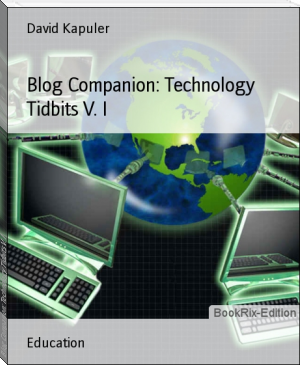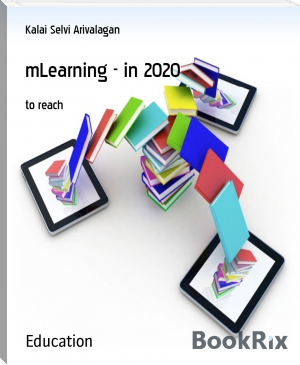INNOVATIONS IN SCIENCE, TECHNOLOGY AND MATHEMATICS EDUCATION IN NIGERIA by Ebele C. Okigbo, Nneka R. Nnorom, Ernest O. Onwukwe (the ebook reader .txt) 📖

- Author: Ebele C. Okigbo, Nneka R. Nnorom, Ernest O. Onwukwe
Book online «INNOVATIONS IN SCIENCE, TECHNOLOGY AND MATHEMATICS EDUCATION IN NIGERIA by Ebele C. Okigbo, Nneka R. Nnorom, Ernest O. Onwukwe (the ebook reader .txt) 📖». Author Ebele C. Okigbo, Nneka R. Nnorom, Ernest O. Onwukwe
In Abia State, the students’ performance record in Mathematics at the West Africa Senior Secondary School Certificate Examination (WASSSCE) from 2013 to 2017 is a reflection of general poor performance in Nigeria. The analysis has shown that the percentage of students who passed at credit level and above (A1 –C6) was less than 50% within 2013 to 2017 in Imo State (Secondary Education Management Board (SEMB), Owerri Imo State, 2017).Corroborating this assertion, the WAEC Mathematics Chief Examiners (2012-2015) reported that many candidates do not attempt questions drawn from geometry and those who attempted the questions showed lack of understanding of the concept of geometry especially the three-dimensional shapes, circle theorem among others. This has shown that achievement of students in geometry has been very poor.
Geometry is a branch of mathematics which has applications in careers such as art, architecture, interior design, carpentry, plumbing and drawing (Okigbo & Okeke, 2011). Geometry provides knowledge of how to deal with measurements and relationships of lines, angles, surfaces and solids (Abiodun, 2016). Geometry is one of the five themes in senior secondary school Mathematics curriculum(Nigerian Educational Research & Development Council(NERDC), 2007).The topics under geometry as a theme include;constructions, proofs of some basic equations, trigonometric ratios, menstruation(two and three-dimensional shapes), chord property and circle theorems. Others are trigonometry, graphs of trigonometric ratios, surface area and volume of sphere, longitude and latitude and coordinates geometry of straight lines(NERDC,2007). In this study, therefore, three-dimensional shape is the focus. Three-dimensional shape is an object that has face or flat surface, edge, vertex. For example, three dimensional shapes include cube, cuboid, cylinder, cone, pyramid, prism, prism, sphere among others. Three-dimensional shapes provides knowledge of how to deal with measurements and relationships of surfaces and solids(Njoku, 2015).The knowledge of three-dimensional shapes is used in engineering especially the structural engineers in designing structures and in graphic arts to calculate perspective. Overtime, the method used by secondary school Mathematics teachers in the teaching ofthree-dimensional shapes is conventional teaching method.
Conventional Teaching Method (CTM) is a teacher-centered, Nworgu (2017) submitted that conventional Teaching method is characterized by verbalization, memorization, non-interactive, and teacher dominance. Many mathematics teachers make use of it in teaching mathematics because it allows for a wider coverage of content within a short period of time and teaching large number of students at the same time (Osuafor and Njoku, 2016).Despite this advantage, achievement of secondary school students in geometry has been poor. To this end, effort is made by this study to attempt to evolve a strategy that can be used to teach geometry to secondary school students in order to improve their achievement in geometry. In this study, achievement in geometry is defined as the ability of the students to comprehend three dimensional shapes in geometry and perform the required calculations accurately when measure with an achievement test. To this end, there is need to explore a student centred teaching method which seemingly has the capacity to improve achievement of secondary school students. Such strategy is seen inHands-on Knowledge Concept (HKC).
Hands-on Knowledge Concept (HKC) is a process of engaging students in the construction of shapes with cardboard paper or other malleable materials to get skills rather than read about it or seeing it being done by others, before teaching the calculation involved in the concept.HKC enables students to learning a topic with some prior knowledge. In line with submission of McGrew (2005), that it is much easier to learn information that is in one's existing field of expertise than to learn information from a brand new field. In this study, HKC involves teaching students how to construct solid geometry such as cube, cuboid, cone, cylinder, prism and pyramid using cardboard sheet, solo or masking tape and scissors for about 20 minutes before teaching them how to calculate total and curved surface areas, and volume. On the strength of the forgoing, it became necessary to conduct a research on the effect of Hands-on Knowledge Concept (HKC) secondary school students’ achievementin mathematics and determine the influence of gender on the secondary school students’ achievement in geometry.
Gender is an important variable in educational research. Okoli (2011) described it as the social or cultural construct, characteristics, behaviours and roles which society ascribes to females and males. Overtime, there has not been agreement by researchers on the influence of gender on achievement scores of secondary school students. Therefore, gender has remained a controversial and an inconclusive issue amongst science educators and psychologists. For example, Garba, and Muhammad (2015) reported that there was a significant influence of gender on the mean achievement scores of students in geometry. Whereas Osuafor and Njoku (2016) reported that there was no significant influence of gender on the mean achievement scores of students. Hence, the present study gave a clarification on the issue and filled the gap of information on the influence of gender on students’ achievement scores in geometry.
Purpose of the StudyPurpose of the Study
The purpose of this study was to determine the effect of HKC of three dimensional shapes on students’ achievement in geometry. Specifically, this study determined the:
Effect of HKC of three dimensional shapes on the achievement of secondary school students in geometry.
Influence of gender on mean achievement scores of students in geometry.
Interaction effect of teaching method and gender on mean achievement scores of students in geometry.
Research QuestionsResearch Questions
The following research questions guided the conduct of the study:
What are the mean achievement scores of students exposed to HKC of three dimensional shapes and those exposed to Conventional Teaching Method(CTM) in geometry?
What are the mean achievement scores of male and female students exposed to HKC of three dimensional shapes in geometry and those exposed to CTM in geometry?
HypothesesHypotheses
The following hypotheses guided the study. They were tested at 0.05 levels of significance.
There is no significant difference between the mean achievement scores of students who were taught geometry using HKC of three dimensional shapes and those taught using CTM.
There is no significant influence of gender on mean achievement scores of students in geometry.
There is no significant interaction effect of teaching method and gender on mean achievement scores of students in geometry.
Method
Research Design
The design of this study was quasi-experimental. Specifically, the non-equivalent control group design was adopted. The study was carried out in senior secondary schools in Abia State, Nigeria.
Sample and Sampling Techniques
The sample for the study was made up of 274(123 male and 151 female)Senior Secondary one (SS1) students with average age of 14 years. The sample was selected through a multistage sampling procedure. Six schools were chosen for the study(two single sex boys, two single sex girls and two co-educational). Thereafter, three were randomly assigned to experimental group and the other three to control group. Six intact classes were sampled for this study.
Instrument for Data Collection
Three -Dimensional Shapes Achievement Test (TDSAT) was used as instrument for data collection in this study. This instrument was constructed by the researchers. It consists of two parts namely the preliminary part which provides information on getting bio-data information of the students and the part contains 40-item multiple-choice questions with four response options. The instrument was face and content validated by specialists and also trial tested. The reliability of TDSAT was established using Kuder Richardson formula 20 (KR-20). Internal consistency of 0.79 was obtained. Similarly, since the instrument was used twice, hence the need for the estimation of temporal stability of the instrument. Test-retest which was found to be 0.82 was used to estimate the temporal stability of TDSAT. Afterwards, item analysis was conducted on TDSAT in order to fully standardize the instrument. Finally, the difficulty indices of the items were used in arranging TDSAT items according to their increasing order of difficulty. TDSAT was used as pre-test and after the treatment has been made, the same instrument was re-arranged and used as post-test.
Experimental Procedure
The researchers coordinated the regular mathematics teachers of the selected schools for the experimental group on how to use the HKC for one week. Thereafter, copies of the lesson plan were given to each of the teachers in experimental group. However, the teachers in the control group were giving only the validated copy of lesson plan.Before starting the teaching, TDSAT (pre-test) was administered to the students in the two groups to answer and no feedback on the TDSAT (pre-test) scores was given to students in
 The desire to acquire knowledge about the surrounding world and human society is quite natural and understandable for a person. Life is so developed that an uneducated person will never occupy a high position in any field. Humanity in its mass, and each person individually, develops objectively, regardless of certain life circumstances and obstacles, but with different intensity. The speed of development depends on the quality of training.
The desire to acquire knowledge about the surrounding world and human society is quite natural and understandable for a person. Life is so developed that an uneducated person will never occupy a high position in any field. Humanity in its mass, and each person individually, develops objectively, regardless of certain life circumstances and obstacles, but with different intensity. The speed of development depends on the quality of training.




Comments (0)